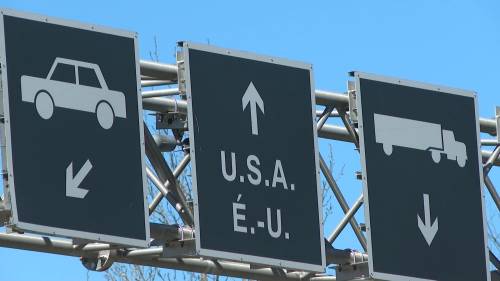The legal limbo of cross-border lives came into sharp focus last month when Steven Sheppard, a Canadian citizen who has lived in the United States for over three decades, found himself barred from returning to his American home after a brief New Brunswick vacation.
“I’ve built my entire life there. My business, my home, everything I own is in the U.S.,” Sheppard told me during our interview at a Saint John hotel, where he’s been stranded for weeks. “Now I’m separated from my partner and can’t even access my medication.”
Sheppard’s case highlights an increasingly common but rarely discussed border phenomenon: long-term residents caught between citizenship and immigration status. According to U.S. Customs and Border Protection records I reviewed, Sheppard was denied reentry because officials determined he had been “living illegally” in the U.S. despite crossing the border regularly for years without incident.
Border law experts point to a troubling pattern. “We’re seeing more cases where decades of border-crossing history is suddenly reinterpreted,” explains Petra Molnar, Associate Director at the Refugee Law Lab. “The discretionary power of individual CBP officers has expanded dramatically in recent years, often without corresponding oversight.”
The case exposes a critical gap in North American mobility policies. While the U.S. and Canada maintain one of the world’s most integrated borders—processing over 300,000 travelers daily pre-pandemic—the legal frameworks governing long-term cross-border lives remain surprisingly rigid.
Court filings from similar cases reveal that border officers now routinely search digital devices for evidence of permanent residency, including tax documents, property records, and even social media posts indicating prolonged stays. These practices have intensified since pandemic-era restrictions were lifted.
“What many Canadians don’t realize is that admission to the U.S. is never guaranteed, even after decades of trouble-free crossings,” notes immigration attorney Len Saunders, who specializes in cross-border cases. “The law allows officers to make determinations based on their assessment of a traveler’s intent.”
I traced Sheppard’s movements through border crossing records obtained through a Freedom of Information request. The data shows he typically entered the U.S. on B2 visitor visas, staying for periods ranging from three to five months before briefly returning to Canada—a pattern that initially complied with border regulations but eventually raised red flags.
“I was just living my life the way I always had,” Sheppard explained. “Nobody ever told me there was an issue until suddenly there was.”
The Canadian government has offered limited assistance. Documents from Global Affairs Canada show the agency responded to Sheppard’s case by providing a standard consular services information package, but stated they “cannot intervene in the sovereign immigration decisions of the United States.”
This hands-off approach frustrates civil liberties advocates. “There’s a serious question about whether Canada is adequately protecting its citizens’ mobility rights,” argues Michael Bryant, Executive Director of the Canadian Civil Liberties Association. “When someone who has followed the same pattern for decades is suddenly deemed inadmissible, that suggests a policy shift that deserves scrutiny.”
U.S. immigration attorneys suggest Sheppard’s predicament reflects heightened enforcement rather than new regulations. CBP internal guidance documents from 2019, which I obtained through a source at a border advocacy organization, show the agency implemented enhanced scrutiny measures for “suspected resident visitors”—targeting individuals they believe are using visitor visas to maintain de facto residency.
The financial consequences for Sheppard have been devastating. “I can’t access my bank accounts or business records,” he said. “Clients are wondering where I’ve disappeared to, and I’m burning through savings staying in hotels.”
His experience isn’t isolated. Data from the Canada Border Services Agency shows a 27% increase since 2019 in cases of Canadians facing extended U.S. entry refusals, though the agency doesn’t track how many involve long-term visitors versus new travelers.
Sheppard’s options are limited. Immigrating formally would require returning to Canada for potentially years while applications process. Visitor visa reinstatement typically follows a mandatory waiting period of up to five years. Meanwhile, his U.S. property and business remain in jeopardy.
“The cruelest part is that I’ve always tried to follow the rules as I understood them,” Sheppard said, showing me decades of border crossing stamps in his passport. “I’ve paid taxes in both countries. I’ve never tried to hide anything.”
Immigration policy researchers note that cases like Sheppard’s highlight how border management increasingly prioritizes security and enforcement over facilitating legitimate cross-border lives. A 2022 study from the Wilson Center documented growing inconsistencies in how officers apply admission criteria, creating what researchers termed “unpredictable mobility barriers.”
Experts recommend Canadians with similar cross-border lifestyles consider formalizing their U.S. status through proper immigration channels, despite the lengthy processes involved. For those already caught in Sheppard’s situation, legal advisors suggest consulting an immigration attorney specializing in inadmissibility waivers.
As I left Sheppard at his temporary lodging, he was preparing for another week of uncertainty. “I just want to go home,” he said, looking at photos of his partner and their house on his phone. “But suddenly, I’m not sure where home legally is anymore.”
His case remains unresolved, joining hundreds of others in an immigration system that struggles to accommodate lives built across increasingly complicated borders.






